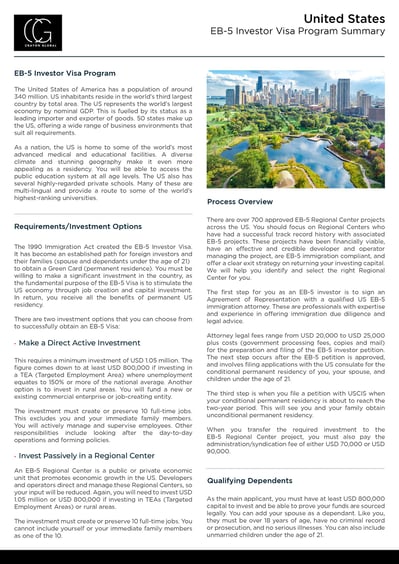Global Freedom Meets Financial Sophistication.™
US EB-5
1/11/20255 min read






US EB-5 Immigrant Investor Program
Overview:
The EB-5 Immigrant Investor Program, administered by the United States Citizenship and Immigration Services (USCIS), offers foreign investors the opportunity to obtain a U.S. Green Card (permanent residency) through investment in a U.S. business. Established by Congress in 1990, the program aims to stimulate the U.S. economy by creating jobs and attracting capital investment from foreign nationals. In return, investors, their spouses, and unmarried children under the age of 21 can receive permanent U.S. residency.
The program provides two paths to obtain a Green Card: direct investment and investment through a Regional Center. The key requirement for both paths is that the investment must lead to the creation of at least 10 full-time jobs for U.S. workers.
Key Components of the EB-5 Program
1. Investment Requirements:
- Minimum Investment Amount:
- As of March 15, 2022, the minimum investment amount is set at $1,050,000 for standard EB-5 investments.
- A lower minimum of $800,000 applies to investments in Targeted Employment Areas (TEAs), which are rural areas or regions with high unemployment rates.
- The investment must be "at risk," meaning it cannot be guaranteed or placed in escrow until after the EB-5 petition is approved. Investors must show that the invested funds are committed to the project and at risk of being lost.
2. Job Creation Requirements:
- Each EB-5 investor’s capital must create or preserve at least 10 full-time jobs for U.S. workers within two years of the investor's admission to the United States as a conditional permanent resident.
- Direct Investment Path: Investors must create direct jobs—meaning actual positions within the commercial enterprise that the investor owns or operates.
- Regional Center Path: Investors may satisfy the job creation requirement through indirect or induced jobs, which are calculated based on economic models. This allows more flexibility in fulfilling the job requirement, as jobs created by contractors or ancillary businesses may be counted.
3. Regional Centers:
- A Regional Center is an economic unit, public or private, that promotes economic growth, regional productivity, job creation, and increased domestic capital investment. Most EB-5 applicants opt to invest in projects through USCIS-approved Regional Centers because these allow investors to count both direct and indirect job creation.
- As of recent updates, the EB-5 Reform and Integrity Act of 2022 reauthorized the Regional Center Program until 2027, ensuring its continued viability as a pathway to U.S. permanent residency.
4. Targeted Employment Areas (TEAs):
- High-Unemployment Areas: These are areas that have an unemployment rate of at least 150% of the national average.
- Rural Areas: Defined as regions outside of any metropolitan statistical area (MSA) and any city or town with a population of 20,000 or more.
The EB-5 Application Process
1. Investment and Petition Filing (Form I-526):
- The investor must choose an investment project (either direct or through a Regional Center) and commit the required capital. After making the investment, the investor files Form I-526, Immigrant Petition by Alien Investor, with USCIS. This petition must include evidence of the investor’s source of funds, proof that the investment is at risk, and a business plan demonstrating job creation.
2. Conditional Permanent Residence (Form I-485 or DS-260):
- Once the I-526 petition is approved, the investor can apply for conditional permanent residency, which lasts for two years. Investors who are already in the U.S. can file Form I-485, Application to Register Permanent Residence or Adjust Status, while investors outside the U.S. apply for an immigrant visa at a U.S. consulate through Form DS-260.
3. Removal of Conditions (Form I-829):
- Ninety days before the two-year conditional residency expires, the investor must file Form I-829, Petition by Investor to Remove Conditions on Permanent Residence. This petition must include evidence that the investor fulfilled the job creation requirement and maintained the investment during the conditional residency period. Upon approval, the investor, along with eligible family members, will receive permanent Green Cards.
Costs and Fees
- Investment Capital: $800,000 for TEA investments; $1,050,000 for non-TEA investments.
- USCIS Fees:
- Form I-526 Filing Fee: $3,675
- Form I-485 Filing Fee: $1,225 per person
- Form I-829 Filing Fee: $3,750
- Legal Fees: Investors typically engage immigration attorneys and corporate counsel to assist with the EB-5 process, adding $15,000 to $50,000 depending on the complexity of the case.
- Regional Center Fees: If investing through a Regional Center, there may be additional administrative and management fees, typically ranging from $50,000 to $70,000.
Advantages of the EB-5 Program
1. Direct Path to U.S. Permanent Residency: The EB-5 program offers a clear path to a Green Card, enabling the investor, spouse, and children under 21 to live, work, and study anywhere in the U.S.
2. No Sponsorship Required: Unlike other employment-based Green Card categories, EB-5 investors do not need a U.S. employer to sponsor them.
3. Access to U.S. Education System: The EB-5 visa enables the investor’s family to access the U.S. education system, including in-state tuition rates at U.S. universities.
4. Potential for Citizenship: After holding a Green Card for five years, EB-5 investors and their families can apply for U.S. citizenship.
Challenges and Risks
1. At-Risk Requirement: The "at-risk" requirement of the investment means that there is no guarantee of a return on investment or even the return of the original capital. Investors must be willing to accept the possibility of financial loss.
2. Job Creation: The success of the investment hinges on meeting the job creation requirement, which can be complex, particularly for direct investments.
3. Processing Delays: The EB-5 program has historically been subject to lengthy processing times, with backlogs in certain countries (particularly China, India, and Vietnam). This can delay the approval of petitions and the removal of conditions on residency.
Recent Developments and Legislative Updates
1. EB-5 Reform and Integrity Act of 2022:
- The reauthorization of the Regional Center Program introduced several reforms, such as enhanced reporting requirements, stricter oversight, and transparency measures to protect investors.
- The new law increased the minimum investment amounts and designated more stringent requirements for TEA designation.
2. Visa Availability:
- The EB-5 program is subject to annual visa caps, and certain countries with high demand, such as China, India, and Vietnam, face longer wait times due to oversubscription.
3. Priority Processing for Rural Projects:
- As part of the reforms, projects in rural areas now receive priority processing to incentivize investment in underdeveloped areas.
Conclusion
The EB-5 Immigrant Investor Program provides foreign nationals with a unique opportunity to obtain U.S. permanent residency through investment in the U.S. economy. It offers significant benefits, including permanent residency for the investor and their family, access to U.S. education, and potential citizenship. However, investors must be aware of the financial risks, processing times, and regulatory complexities involved in the program.
With ongoing legislative changes and reform efforts, the EB-5 program continues to evolve, but it remains a viable option for individuals seeking a path to U.S. residency through investment.
Contact
📍 7700 Hurontario St Unit 503, Brampton ON, L6Y 4M3 Canada
📞 +1 980 281 0777
✉️email@crayonglobal.com


©Crayon Global 2025. All rights reserved.
Get in Touch
